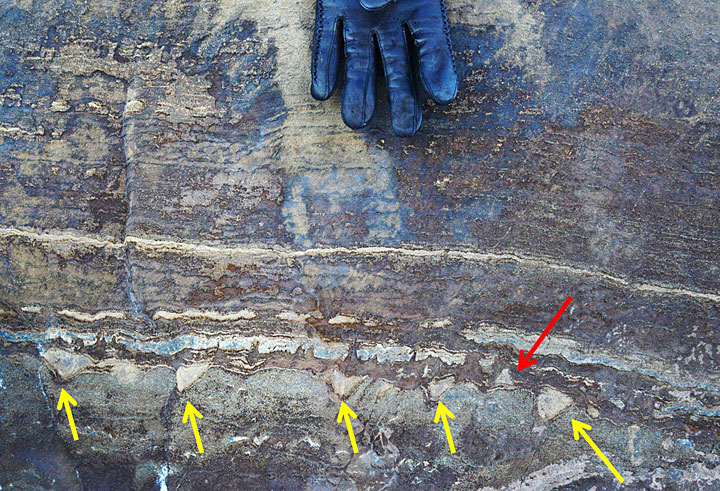3.7-billion-year-old Structures Formed by Tectonics, not Life
January 22, 2019
 enlarge
enlarge
This new study of what were initially thought to be structures of biological origin in Greenland suggests they might instead just be mineral structures created when ancient tectonic forces squeezed stone. While most of the structures point in one direction, the red arrow shows that some point in the other direction. Courtesy of Abigail Allwood
An international collaboration of scientists re-examined “fossils” that were considered early evidence of life in 3.7-billion-year-old rock structures in Greenland and found that the structures were of geological origin. To investigate the elemental composition of the rock structures, the scientists used ultrabright x-rays from the National Synchrotron Light Source II (NSLS-II), a U.S. Department of Energy (DOE) Office of Science User Facility located at DOE’s Brookhaven National Laboratory.
The 3.7-billion-year-old rock structures are part of Earth’s oldest rocks, the Palaeoarchean Isua supracrustal belts in Greenland, which are a prime target in the search for the earliest evidence of life on Earth. The samples studied here were recently exposed by the retreat of Greenland’s glacial ice cover. Finding evidence and dating the first beginnings of life on Earth has important implications for our understanding of how life emerged and evolved.
“If proven to be of biological origin, these rocks ?would represent the first discovery of a morphological biosignature in Earth’s oldest rocks and establish the start of the fossil record 200 million years earlier than previously thought,” said Joel Hurowitz, an assistant professor at Stony Brook University and co-author on the study. “However, the Isua belt is an area known to have been broadly affected by intense metamorphism, which led us to be skeptical of recent claims that the rocks there preserve evidence for ancient biology.”
Metamorphism describes the change of minerals or geologic textures over the course of history through heat, pressure, and the introduction of fluid.
In a previous study on samples from the same location, a research team led by Allen Nutman of the University of Wollongong in Australia concluded that the samples in question were of biological origin and therefore would represent the earliest signs of life on Earth. Some of their conclusions were based on research techniques that only offered information about the structure of the rocks on a millimeter scale. However, it was suspected that these rocks contained numerous sub-millimeter features that would be critical to understanding their origin and metamorphic history.
To reevaluate the earlier findings, the team of scientists, including Hurowitz, turned to the beamline team of NSLS-II’s Submicron Resolution X-ray (SRX) beamline. The SRX beamline offers ultrabright x-rays that can be focused on a micrometer-sized area, which is 1,000 times smaller than the millimeter scale.
“We used a technique called x-ray fluorescence microscopy to determine the elemental composition of the samples on the micrometer scale,” said Juergen Thieme, beamline scientist at SRX and science coordinator of the Imaging and Microscopy Program at NSLS-II. “For this, we scanned the sample using the beamline’s tiny x-ray spot and detected the x-ray fluorescence signal coming from the sample. The signal is specific to each element present and maps the location and abundance of each element in the sample at the micron scale. Our elemental maps support the identification of the minerals in different layers of the rock samples.”
Combining the x-ray florescence maps with additional analyses, the scientists revealed crucial new evidence that the rock formations are of non-biological origin. Instead, they determined it was more plausible that the rock structures were formed through the natural geological process of metamorphism.
The researchers say these results provide valuable lessons in the search for biosignatures in the Earth’s ancient geological record, as well as the search for life on Mars or other planets. Scientists working on upcoming space missions will need to cautiously interpret evidence for extraterrestrial life until samples can be returned to Earth and analyzed using powerful analytical capabilities, such as those at NSLS-II.
Brookhaven National Laboratory is supported by the Office of Science of the U.S. Department of Energy. The Office of Science is the single largest supporter of basic research in the physical sciences in the United States, and is working to address some of the most pressing challenges of our time. For more information, please visit science.energy.gov.
Follow @BrookhavenLab on Twitter or find us on Facebook.
2019-14345 | INT/EXT | Newsroom









